Facebook’s $5 Billion IPO, By The Numbers [CHARTS]
Facebook has filed its IPO paperwork and the S-1 statement contains an utterly dizzying amount of statistics. The numbers provide a glimpse into Facebook’s stunning growth since its founding in 2004, with a particular emphasis on what’s been happening over the past three years. Here’s a look in graphical/chart form at some of the most […]
 Facebook has filed its IPO paperwork and the S-1 statement contains an utterly dizzying amount of statistics.
Facebook has filed its IPO paperwork and the S-1 statement contains an utterly dizzying amount of statistics.
The numbers provide a glimpse into Facebook’s stunning growth since its founding in 2004, with a particular emphasis on what’s been happening over the past three years. Here’s a look in graphical/chart form at some of the most compelling facts and figures from Facebook’s S-1 filing.
Facebook’s User Base
Facebook’s global user base is growing dramatically, and has been for years. Facebook says it has 845 million “monthly active users” around the world as of December 31, 2011. That’s up 39 percent from the end of 2010.
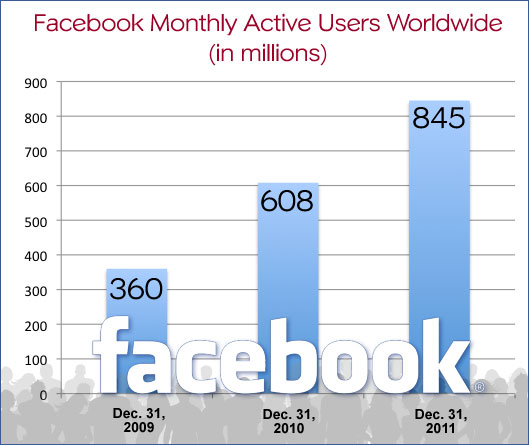
How does Facebook define a “monthly active user”? Here’s what the S-1 says:
We define a monthly active user as a registered Facebook user who logged in and visited Facebook through our website or a mobile device, or took an action to share content or activity with his or her Facebook friends or connections via a third-party website that is integrated with Facebook, in the last 30 days as of the date of measurement.
What’s even more stunning than that figure is the fact that more than half of Facebook users are active every day. Facebook reports 483 million daily active users as of December 31, 2011. That’s a 48 percent increase since the end of 2010. (Facebook’s definition of a daily user is the same as the monthly definition above, but changes the ending to “on a given day” instead of “in the last 30 days.”)
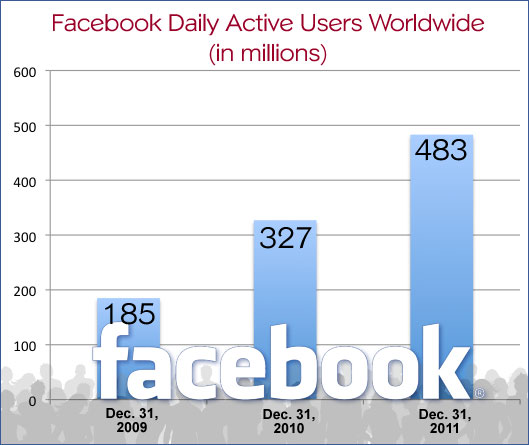
The S-1 also includes this testament to how Facebook is a daily ritual for a large portion of its user base: “During the month of December 2011, we had on average 360 million users who were active with Facebook on at least six out of the last seven days.”
Wondering where Facebook’s users are located? The S-1 reveals that, too. About 80 percent of Facebook’s monthly active users are located outside the US. Here’s a breakdown of the 845 million monthly active user base into three geographical areas, plus “rest of the world” (which includes Africa, Latin America and the Middle East).
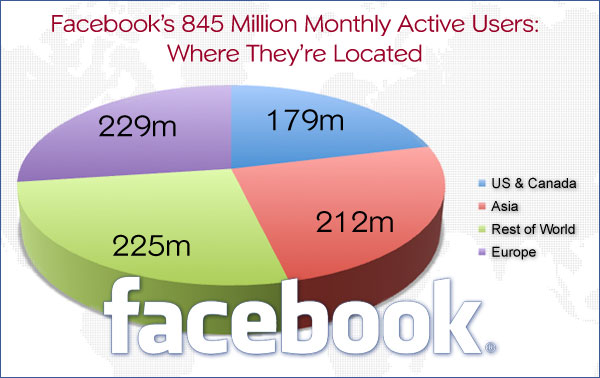
Facebook says Brazil and India were two areas of significant growth in 2011, with its user base rising 268 percent and 132 percent, respectively, in those two countries.
The S-1 says that Facebook’s overall penetration of Internet users is highest — estimated at more than 80 percent of the online population — in countries like Chile, Turkey and Venezuela. In the US and UK, Facebook estimates its Internet penetration at about 60 percent; in Brazil, Germany and India – about 20 to 30 percent; in Japan, Russia and South Korea – less than 15 percent; and in China, Facebook says it has near zero percent penetration because Facebook access is restricted there.
Facebook’s Revenues & Spending
Facebook reported revenue of $3.71 billion in 2011, an 88 percent increase over its 2010 revenue of $1.97 billion and nearly five times its 2009 revenue of $777 million.

The lion’s share of Facebook’s revenue comes from advertising, but the percentage is declining over the past couple years. Facebook reports that 85 percent of its 2011 revenue came from ads, down from 95 percent in 2010 and 98 percent in 2009.
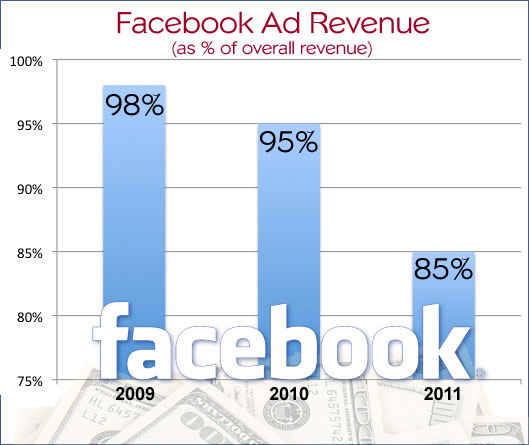
Facebook’s non-ad revenue comes from its payments system that allows users to buy virtual and digital goods from Facebook developers. One of the real stunning numbers from the S-1 is that one developer — the game-maker Zynga — was responsible for 12 percent of Facebook’s overall revenue in 2011. Zynga’s contribution to Facebook’s bottom line was less than 10 percent in both 2009 and 2010. The S-1 statement says that Facebook and Zynga agreed to anaddendum to the standard Payments agreement in May 2010:
In May 2010, we entered into an addendum to our standard terms and conditions with Zynga pursuant to which it agreed to use Facebook Payments as the primary means of payment within Zynga games played on the Facebook Platform. Under this addendum, we retain a fee of up to 30% of the face value of user purchases in Zynga’s games on the Facebook Platform. This addendum expires in May 2015.
One of the main areas that Facebook says it’s upped its spending in recent years is in research and development. Those costs have gone from $87 million in 2009 to almost $400 million in 2011.
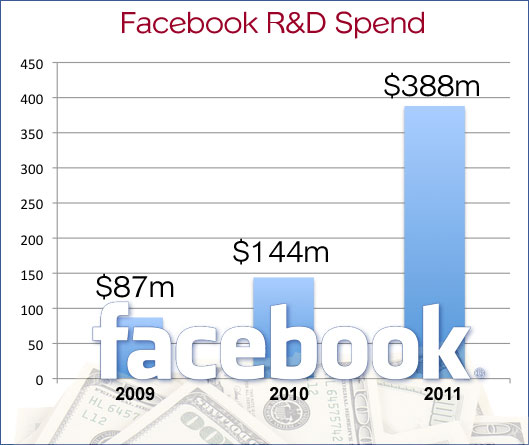
Facebook Employees
Facebook’s growth is also evident in the company’s size. Full-time employees now number 3,200 — almost triple the number of F/T employees at the end of 2009.

That 3,200 figure is an increase of 50 percent from the end of 2010. Facebook also says it has 30 sales offices around the world, and uses about 1.9 million square feet of office space worldwide — including one million square feet of space at the corporate HQ in Menlo Park, California.
Miscellaneous Facebook Statistics
There are a number of standalone statistics included in Facebook’s S-1. I’ll wrap up this article by including them in bullet point form to make sure they’re part of the overall record. These are copied verbatim from the S-1, thus the references to “our” and “we” below.
- There were more than 100 billion friend connections on Facebook as of December 31, 2011.
- On average more than 250 million photos per day were uploaded to Facebook in the three months ended December 31, 2011.
- Our users generated an average of 2.7 billion Likes and Comments per day during the three months ended December 31, 2011.
- As of December 31, 2011, there were more than 37 million Pages with ten or more Likes.
- More than seven million apps and websites were integrated with Facebook as of December 31, 2011.
- In 2011, our Platform developers received more than $1.4 billion from transactions enabled by our Payments infrastructure.
- As of December 31, 2011, we had 56 issued patents and 503 filed patent applications in the United States and 33 corresponding patents and 149 filed patent applications in foreign countries relating to social networking, web technologies and infrastructure, and related technologies. Our issued patents expire between May 2016 and June 2031.
There are also a number of mobile-related facts and figures in the S-1, and Greg Sterling has covered that angle in a separate article.
Again, if you want to read through the document on your own, knock yourself out!
(Stock images used in charts are via Shutterstock.com and used under license.)
Contributing authors are invited to create content for MarTech and are chosen for their expertise and contribution to the martech community. Our contributors work under the oversight of the editorial staff and contributions are checked for quality and relevance to our readers. MarTech is owned by Semrush. Contributor was not asked to make any direct or indirect mentions of Semrush. The opinions they express are their own.
Related stories